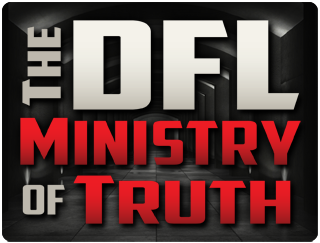The Strib finally did it.

The Strib’s editorial board, in serving in its unstated capacity as stenographers for the DFL and its agenda, have written some howlers over the years; countering them has provided a constant source of material for Minnesota’s large, thriving center-right alternative media for a solid decade now.
But over the weekend, they pulled off the unthinkable – the triple three-peat, the three-minute mile, winning 164 games in a regular season of editorial writing.
They wrote an editorial that was absolutely devoid of truth, or of objective fact. Literally, not one assertion in the entire column about Representative Cornish’s “Stand Your Ground” bill is true, or not presented in a context that isn’t 180 degrees misleading.
An editorial that is, to a moral and ethical “T”, perfectly untrue beyond simple things like “the legislature passed…” or “Jim Backstrom is…”, obviously).
The thought of cataloging all the individual lies in this editorial is almost too daunting. But if not me, who?
Now that the Legislature has passed a bill that would allow gun owners to use deadly force anywhere they feel threatened, only Gov. Mark Dayton can prevent it from becoming law.
This statement starts out with a bang (as it were), proving the stenographer writer’s absolute ignorance on the subject. Minnesota law currently says you can use lethal force when you feel threatened. The bill doesn’t change the justifications for lethal force. Not at all. It has nothing to do with how the law-abiding shooter “Feels”.
It has to do with the burden of proof in judging their motives, and only under certain circumstnces.
More later.
Known as an expanded version of the “castle doctrine,” the bill would allow Minnesotans to shoot to kill even if they aren’t at home. The state’s current castle law already allows citizens to use deadly force in their homes to protect themselves.
This statement is proof that the writer is just re-writing a press release from Heather Martens.
Minnesotans – and residents of any state, for that matter – can already use lethal force to defend themselves, in or out of their homes. Self-defense has been an accepted part of the law since before there was a United States.
The problem in MInnesota is that self defense is called an “affirmative defense”; you plead guilty to shooting someone, with an explanation. You are then guilty until you prove yourself innocent, and show to the court’s and jury’s satisfaction that you were…:
- An unwilling participant
- in reasonable fear of death or great bodily harm
- that lethal force was justified
- that you made a reasonable effort to disengage.
The “Stand Your Ground” law would make one change; if you shoot someone on your property – your house, your yard, your garage, in your car or a business you own – the burden of proof switches to the county attorney. The law-abiding shooter on their own property will be innocent until proven guilty.
And that is all.
But the proposed law, more appropriately called the “shoot first” bill by opponents,
And there’s more proof that the editorial is just a rewrite of a Heather Martens press release.
“Shoot First” bill?
Has anyone on the Strib editorial board’s band of logicians ever pondered what happens if you shoot second?
would let gun owners fire at people they perceive as threats — without the expectation that they should first attempt to avoid trouble if possible.
Another lie, another direct crib from Heather Martens’ chanting points. Self-defense shooting is always shooting at “perceived threats”. The bill merely means that, while you’re on your property, the county attorney has the burden of proving that your perception was wrong.
In particular, ‘Shooting people without first trying to avoid trouble” is legal suicide now, and it would be if the law passes.
Minnesota doesn’t need this change. The state already has a conceal-and-carry law, and citizens who choose to arm themselves can already use firearms for protection anywhere within reasonable limits.
Which is true – and irrelevant to the subject of the editorial.
The bill is not about the right to keep and bear arms; that’s in the Constitution. It’s about the right to use them in legitimate self-defense without an undue legal burden.
And as we saw in last month’s story from Iowa, the burden – being considered guilty until proven innocent – can truly be an undue one.
For years, shoot-first expansion has been among the top legislative priorities for the National Rifle Association. The organization believes that gun owners should have unfettered rights to defend themselves whenever and wherever they feel threatened.
That paragraph is more Heather Martens, from the callow, demonizing reference to the NRA, to the weasel-word that barely camouflages a lie (nobody, neither Cornish nor the NRA, supports an “unfettered” right to kill in self-defense; merely reasonable legal protections for everyone, including the shooter) and the face-palming illogic (again – self-defense is always about whether one “feels threatened”; the devil is in the details; they help determine whether that “feeling” reasonable?)
That’s part of the problem: Defining a threat can be very personal — and mistakes can be deadly. Some gun owners may feel nervous because of the way a group of youths is dressed. Others might find members of a different race or culture to pose a threat.
Heather Martens has been my rhetorical kick-toy for most of the past decade – but to the best of my knowledge, she’s never tried to play the race card. I suspect this is the Strib’s editorial board taking some editorial license with Martens’ press release.
You can shoot someone today because you don’t like their clothes, or their race, or their “culture”. You merely have to prove to a jury that you feared being killed or maimed, that lethal force was justified, that you made a reasonable effort to escape the threat of imminent death or mutilation, and that you didn’t seek out the fight.
And the only thing that’ll change – the only thing – under the proposal is that if you are on your property, the county attorney will have to prove that it was wrong.
And the editorial board apparently has no confidence whatsoever in Minnesota’s police or prosecutors’ ability to tell if a shooting is illegitimate – that a shooting was because of fear of the victim’s “race” or “clothes” or “culture” rather than legitimate fear of death.
Whichever is the case, the conclusion – the editorial board is lying – is the same.
And what about those occasions when a person hears a noise and worries that it could be someone who would do them harm? Then there’s the issue of defending one’s life vs. protecting property.
Absolutely none of which changes from current law. If the police and county attorney investigate and believe that there was no legitimate threat to the property owner, the property owner still has a problem. The editorial board – like Heather Martens – is lying about this.
The proposed law allows deadly force to be used against anyone who enters a garage, for example, “by stealth or force.” That means a homeowner could injure someone or take a life over the theft of a car, bicycle or lawn mower.
Let’s take this statement at face value – more than it deserves – and compare and contrast.
An unarmed black Somali youth sneaks into a garage to steal a bike. Homeowner runs to garage and shoots him. The homeowner claims self-defense – that he “felt threatened”.
Current Law: Since the youth was unarmed and there was no evidence that he was a lethal threat to the homeowner, the homeowner’s affirmative defense fails and he’s convicted of murder or manslaughter.
Proposed Law: Since the police investigation shows the youth was unarmed and there was no evidence that he was a lethal threat to the homeowner, the county charges him with murder or manslaughter, and easily proves him guilty.
That’s it.
As Dakota County Attorney James Backstrom pointed out in a Feb. 15 commentary on these pages (“A bill for the trigger-happy? Bull’s-eye”), the modified law would allow people to shoot first and ask questions later whenever they believed they were threatened, regardless of how a reasonable person would have responded under the same circumstances.
And as I showed, then and above, Backstrom was lying and misrepresenting the law.
It speaks volumes that Backstrom and most other state and national prosecutors, as well as law enforcement groups, oppose the proposal.
Yes; it shows, yet again, that they are in the bag for the DFL. Which is a fact – urban “law enforcement groups” like the MN Police Chiefs’ association are primarily political organizations; the chiefs, especially those in the bigger cities, are mainly political offices, appointed by and serving at the pleasure of the (always DFL) governments.
More importantly? These same groups all come out against all Second Amendment expansions. All of them. They all predict dire consequences.
And they are always wrong.
They’re on the front lines and understand that deadly force should be the last resort.
And the bill will not change that one iota. It’ll merely mean prosecutors will have the same burden of proof they have against real criminals.
Rep. Tony Cornish, R-Good Thunder, has supported expanded castle legislation for years, arguing that the change would codify that law-abiding people “have the brains” [love those scare quotes, huh? – Ed] to understand the seriousness of deadly force.
And the record, nationwide, has shown Cornish’s argument to be resoundingly correct.
Cornish, a former police chief, believes the bill is a logical extension of current law and that the change is needed because citizens need to know that they won’t be prosecuted for defending themselves.
But Cornish can’t point to a single case in Minnesota in which someone acting in self-defense was convicted of anything or sent to jail.
It’s deceptive rhetoric – and it’s untrue. I sure can.
Thomas McCuiston – a 125-pound black man – fatally shot a 6’1, drunk, racist attacker with a 50-pound weight advantage who was breaking into his home; he was defending his five year old son. At trial the judge refused to include the part of the statute that referred to “defending ones’ dwelling” into his instructions; they sentenced McCuiston to 15 years. The appellate judge found that the jury instruction was a reversible error; McCuiston was granted a new trial, where the jury got the right instruction and acquitted McCuiston.
There’s one. Want another?
Martin Treptow, who shot at a man who’d been road-raging at him and had him blocked in at a stoplight on Highway 10. The man pointed a gun at Treptow’s pregnant wife as she sat in the passenger seat; Treptow shot the man, who turned out to be an “undercover cop” and member of the now-disgraced Gang Strike Force. Although Treptow was released without even having his carry permit revoked by the Anoka cops, the Anoka County Attorney leaned on Treptow, promising endless prosecution unless he accepted a deal. An unemployed security guard, he didn’t have the resources to fight the case; he pled guilty to lesser charges. It was as complete a miscarriage of justice as I’ve ever seen – and as clear a justification of the Cornish Bill as exists.
Those two cases (and I’ll bank on there being more) distract from the real point, which isn’t necessarily that anyone “goes to jail” because they had to prove their innocence (unlike virtually any real criminal); it’s that they had to spend an average of $50,000 in legal bills against the unlimited resources of the county attorney to defeat a presumption of guilt until proven innocent – a financial hit the county attorney’s office can absorb without a second thought, but which breaks many poorer defendants…
…who plead guilty to lesser charges, and thus don’t count as people “sitting in jail because they were wrongly convicted”, because, hey, they confessed to the lesser crime – and the lesser included charge of being too poor to fight the County Attorney! Indeed, those are the victims of the current system of law; smug upper-middle-class liberals can afford lawyers to fight their way through the system and prove themselves innocent; working class and poor people, like Treptow and McCuiston and Ray Lewis, people who live in lousyh neighborhoods (gutted by DFL policy) who need to defend themselves (against criminals against which the DFL-run city is powerless), but don’t have the resources to fight the county attorney.
So while the editorial is utterly devoid of fact, it is racist, in the way that Strib editorials always are; the racism of “good intentions”, of trying to do the little peoples’ thinking for them. Even if it means you have to doctor the facts to do it.
So why is the Strib editorial board lying? Why is it doing a glossy rewrite of an (I’ll guess, with authority) Heather Martens press release and calling it the institutional voice of the newspaper?
The Strib is lying to the people. Where is the accountability?
Other than the slow dripping of market forces pushing it into irrelevance? There is none.
EXTRA CREDIT QUESTION: How long until Catherine Richert at MPR’s “Poligraph” “fact-checks” this editorial?









